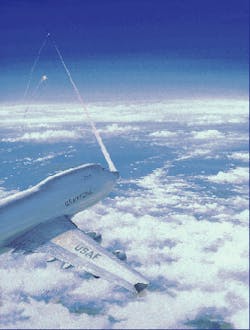The proliferation of laser weapons will reshape global military balances over the next three decades, neutralizing the power of traditional weapons such as tanks and warplanes and triggering a race among nations to develop better and better laser weapons and defenses against them, according to a new industry forecast.
The forecast, unveiled in Washington in October by the Electronic Industries Association (Arlington VA), envisions three phases in military technology between now and 2025, in which lasers will play an increasingly prominent role, finally coming to dominate the battlefield and making much of the United States’ traditional military strength obsolete. A group of industry officials from EIA companies prepared the forecast after interviewing two dozen officials from the US military, US intelligence agencies, defense companies, and think tanks.
The EIA forecasters predict that, from 2005 to 2010, lasers will not be a factor. In this period, nations will arm themselves with huge quantities of inexpensive cruise and ballistic missiles. A nation like China or Iran could accumulate a stockpile of 10,000 cruise missiles equipped with satellite navigation and chemical or biological weapons. By threatening the use of that arsenal, such a country could block the United States from landing troops in a nearby trouble spot such as in the Middle East, says Thomas Jones, head of the study and director of special studies at Boeing Space and Defense Group (Seattle, WA).
But by about 2010, the Pentagon will regain its military might, thanks in large degree to the development of new US laser weapons that will be able to attack enemy planes, missiles and satellites. "Whoever owns the speed-of-light weapons will dominate the battlespace in almost every respect," Jones says. "The speed of light opens a whole new dimension. A capability to shoot down enemy missiles will let us operate our aircraft wherever and whenever we wish." He says that such weapons should be technically feasible, because they need only be powerful enough to penetrate relatively thin materials such as the skin of an airplane or missile. "With the exception of killing satellites, the capability we are talking about does not require huge power levels or great ranges. It will require sufficient numbers, that is, shots and rate of fire."
The US laser weapons could be based in the ground, carried aloft on a plane or even placed into orbit, Jones says. He envisions air- and ground-based lasers for defending airbases, ports, and aircraft carriers that otherwise would be vulnerable to missile attack (see illustration). Airplane-based lasers could be used to defend bombers over enemy territory and to kill enemy ballistic missiles as soon as they were launched. Ground-based lasers could be used in conjunction with orbiting mirrors to extend their range over the horizon. But, Jones warns, "both the space mirrors and the space-based lasers will become vulnerable to enemy speed-of-light weapons, which brings us to the next phase of the revolution."
In that phase, starting by about 2025, the United States will lose its monopoly on laser weapons and, thus, its control of the skies. "We go from airpower utopia to airpower perdition," Jones says. "Neither side will be able to operate aircraft, missiles, or satellites above the horizon of the other’s speed-of-light weapons. This is the most radical shift we can imagine, with truly revolutionary impact on almost every aspect of the military."
In this third phase, airplane-based lasers will no longer be viable weapons, because an enemy’s ground-based laser will be able to destroy planes overhead, Jones says. "Satellites are also likely casualties," he says. This third phase is not "a viable security posture" for the United States, because it will result in increased emphasis on the use of ground troops rather than airpower, and the USA historically has tried to find ways to downplay rather than emphasize the use of ground troops. That may produce pressure within the Pentagon to develop ways to destroy an enemy`s laser systems, Jones says. "A winner could revert to the previous phase and own the battlespace."
Jones says that some in the US defense establishment believe that US enemies would be laid waste by US laser weapons while the Pentagon would be unharmed by the other side`s lasers. Jones says they are wrong. "The laws of physics are two-sided," he says. "This is a contest of mass, melting points, and distance versus power and beam control. In the end, shooting first wins."
"We cannot keep this genie in a bottle," Jones says. Russia already has such weapons, while France, Germany, and China could develop them, he says. "Remember, we are not talking about massive weapons or unobtainable technology."
"There will be a revolution in military affairs because our adversaries are motivated and the ingredients can be bought. It is up to us whether the United States will be the owner or the victim of that revolution," Jones says.
Funding a key
Whether the US owns the revolution may well depend on how much money the US government is willing to spend on weapons and weapons-related research. Because of the expected growth in entitlement spending in the federal budget, the Pentagon may find itself without the funds to exploit the technological revolution in military affairs. Jones says that it may take a crisis, in which a foreign military deals the Pentagon a blow, to galvanize support from the public and Congress for expanded military spending. "It may well be that we get stung and get forced into it," he says.
So what should the Pentagon and US defense industry do? "We need to quit laughing and bring some of the far-out ideas to fruition. In the long term we are likely to need them," Jones says. "We should not like this forecast."
